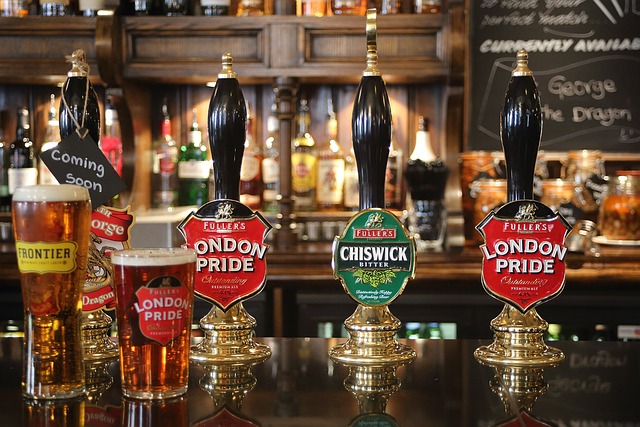
Pubs are so ingrained in UK culture that it’s hard to imagine the nation without them. They’re places for socialising, enjoying refreshments, and being a part of the local community. But how did this relationship with pubs come to be? This article will explore just that by tracing the history of the earliest recordings of pubs to their ubiquitous presence today.
AD 43-410: The Romans & Tabernae
The origins of today’s pubs can be traced back to AD 43, coinciding with the Roman invasion. The Romans established tabernae along roadsides to serve wine, their preferred drink. These establishments eventually started serving ale, a staple in British diets, alongside wine. Over time, the term ‘tabernae’ became ‘tavern.’
AD 410-1066: Anglo-Saxons & Alehouses
As the Romans left England, new invaders made their way to what is now England, once again changing the norms of how towns and villages operated. These invaders, the Anglo-Saxons, hailed from different regions of Europe and established their kingdoms — the names of these kingdoms and the peoples who ruled them are still present in the names used today.
With the increased Anglo-Saxon presence, the number of establishments offering ale increased. These establishments that focused on serving ale over wine became known as alehouses and were so prevalent that King Edgar decided to limit them, only allowing one per village.
AD 1066-1154: The Normans & Inns
As the Norman conquest took over England, norms and ruling powers changed again. Edgar’s decision to limit how many taverns or alehouses a village could have was no longer relevant. This wasn’t the only change that came with this new rule, and inns started to become prominent additions to taverns. They offered tired travellers, military personnel, and anyone else a place to stay and were especially common along busy thoroughfares.
The 1300s: Bar Signs
Bar signs hanging from the exterior of buildings are an expected element of a British pub. We expect it because signage has been part of the pub experience since before the term “pub” was in existence. The use of bar signage, much like pubs in general, has been traced back to Roman tabernae.
Inspired by Romans who would hang vines outside of tabernae to indicate that wine was available, taverns in England that served wine would include a shrub or bush outside their building. The climate of England was so different, however, that vines weren’t an option, leading to the adaptation of shrubbery instead.
Alehouses would hang ale-stirring poles or stakes outside their buildings to indicate that ale was available. Establishments that served both ale and wine would include both shrubs and stakes.
In the 1300s, as naming taverns and alehouses became common, hanging bar signs became common practice, too. By 1393, King Richard II required all taverns, alehouses, and inns to hang a sign or risk forfeiting all the drinks they produced.
The signs used weren’t usually written names, as most people couldn’t read at the time. Instead, they used images to depict what the establishment offered or represent its name. The practice of having images on bar signage is still prevalent today.
The 1500s-1600s: Operator Licences & Public Houses
In 1552, alehouse owners were required to have a licence to operate a tavern or alehouse. During this period, the number of taverns increased exponentially, and they became profitable businesses in high demand. By 1577, it’s estimated that there were over 17,000 alehouses in the England and Wales region.
In the 1600s, the different establishments offering food, drink, and accommodations became known as public houses. The name stems from the fact that the buildings providing these comforts looked no different from other houses in towns and villages, with the exception of their signage.
Over time, the term public house was shortened to pub, which has remained the dominant term.
The 1700s: Gin Influence
The presence of gin in pubs is traced to the early 1700s when it arrived from Holland. The impacts of this spirit were unprecedented. The spirit was cheap and, therefore, a popular option among pubgoers. It also had a reputation for having medicinal properties. While these factors skyrocketed the consumption of gin, it became closely linked to societal problems. To curb the impacts, a series of Gin Acts was implemented.
Around this time, stagecoaches became incredibly common, leading to coaching inns that would include stables for horses and places to keep stagecoaches. Like their earlier counterparts, these inns also offered their guests food and drink, adding to the prominence of pub culture in the UK.
The 1800s: Beerhouse Act
In the early 1800s, it seemed as though gin’s popularity would grow again. The resulting fear led to the 1830 Beerhouse Act, which dramatically reduced the cost of beer and ale, making it the drink of choice above gin.
The Present: Continued Popularity of Pubs
Today, pubs remain social hot spots where people can go for a drink, entertainment, and a bite to eat, and, perhaps most notably, they can socialise with friends and other pub patrons. Even though the number of pubs is decreasing, they are still widely available across the UK, with 58 pubs per 100,000 people. The idea of UK pubs is so ingrained in the UK’s culture that when tourists visit, it’s an essential part of their trip to pop into a local pub and drink in the atmosphere or to venture out on a pub crawl through cities like London.
Conclusion
With nearly 2000 years of history in the UK, pubs provide spaces for refreshments and socialising, welcoming everyone and anyone through their doors. Their presence is an essential part of life in the UK. Although online avenues of entertainment like gambling through sites on casinos.com or catching up with friends via social media are immensely popular, the allure of in-person activities at the local pub still captivates the UK population.

